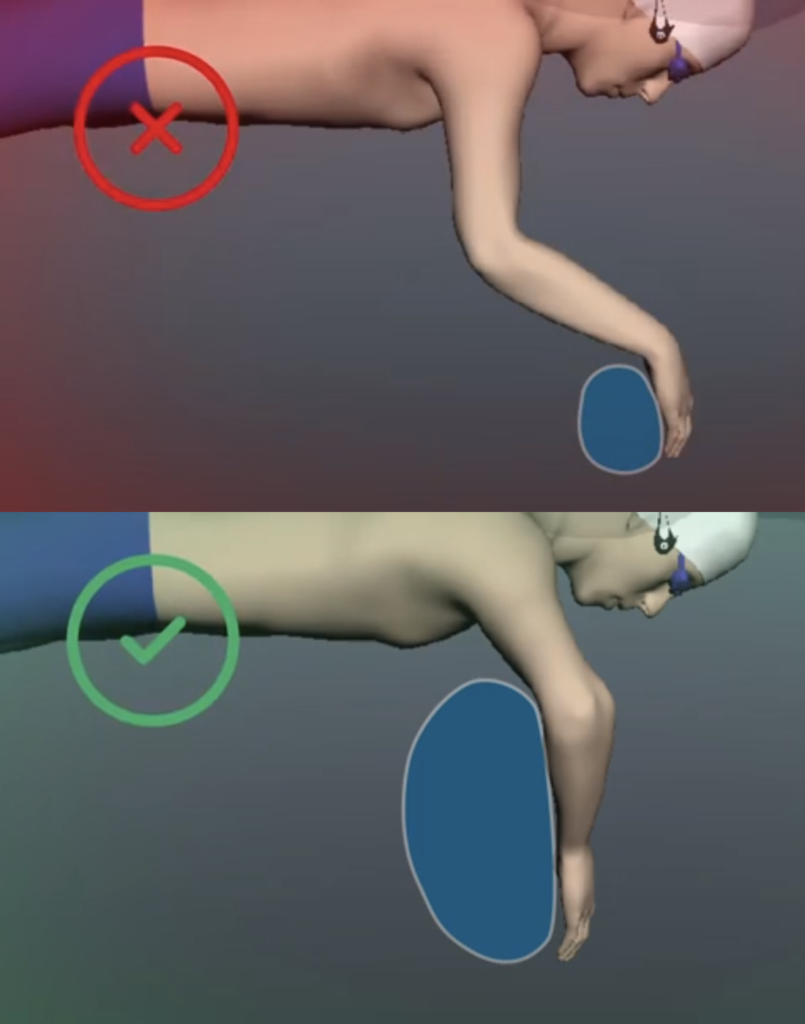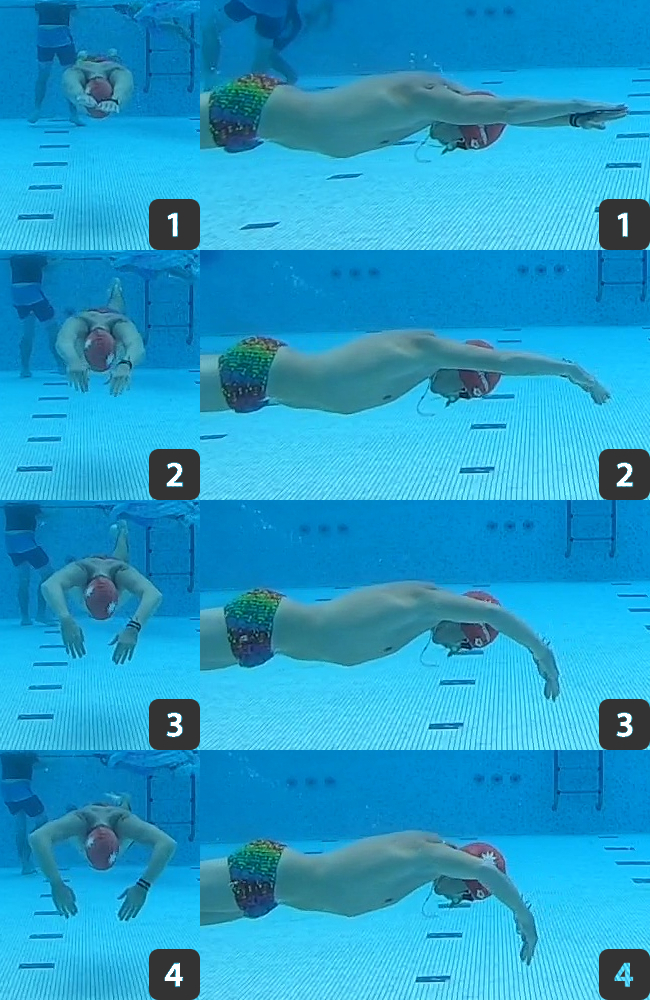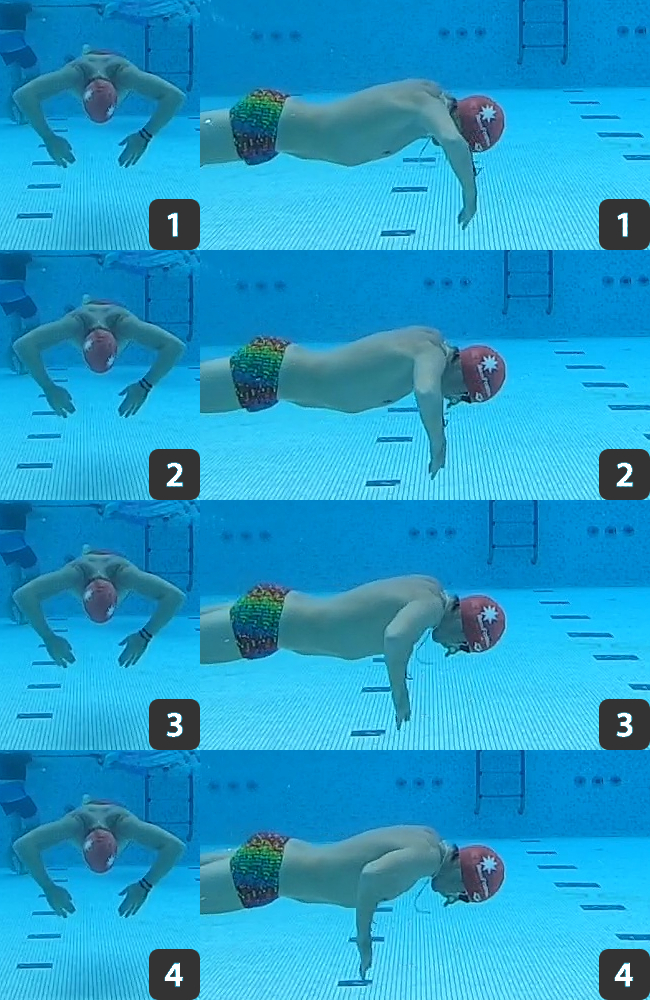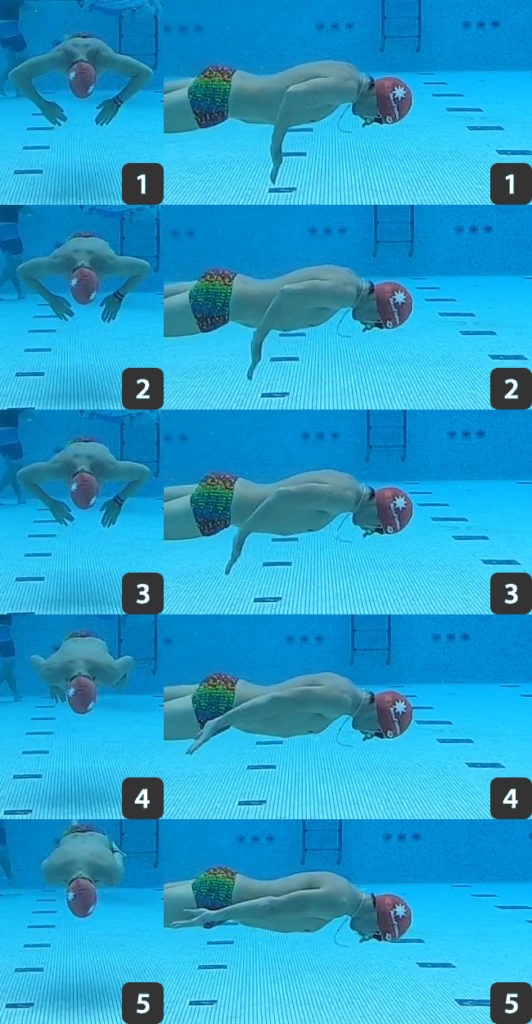Introduction
Propulsion is an important aspect of swimming.
The purpose is to be as efficient as possible, using muscles only when necessary and avoiding the waste of energy.
The majority of the propulsion studies in swimming promotes front crawl. If we look closely at the underwater arm movement and the motor path of the hand, we see that the underwater breastroke and the front crawl have very similar, if not identical, motions and pathways.
The article below expands on this topic.
How to improve my propulsion in freediving ?
First, we have to determine how we are going to study the propulsion. The biggest differences between swimming and freediving regard the direction of swimming (either horizontal or vertical) and the density of the water depending upon depth.
- DIRECTION
Appropriate swimming studies analyze a parallele movement with the surface of the water (or perpendicular to gravity and the buoyancy force); while it’s the opposite in freediving. The direction of the movement is parallele to gravity and buoyancy force (or perpendicular to the surface of the water.)
What does that imply ? Let’s look into that later.
- DENSITY OF THE WATER
To apply the propulsion swimming formula we have to consider one of the variable that will change with the depth : the density of the water.
Deeper we go, the denser the water is.
What does that imply ? Let’s look into that later.
In this article we are going to study the arm movement and the physics law related to propulsion with the arm.
Disciplines
Keeping these arm movements in mind, let’s consider when they come into play for a freediver. The main freediving disciplines being :
- Free immersion (FI)
- Constant Weight (Monofin) (CWT)
- Constant Weight with Bi-Fins (CWTB)
- Constant Weight NO FIN (CNF)
Free immersion (FI)
« The freediver dives under water without the use of propulsion equipment (fins) but uses the rope to pull to descend and ascend. » [AIDA © 2022]
As free immersion is a discipline that does not imply swimming, we will not explore this discipline.
Constant Weight (CWT)
« The freediver descends and ascends with the use of fins/monofin and/or with the use of his arms. »[AIDA © 2022]
Constant Weight with Bi-Fins (CWTB)
« The new discipline allows the freediver descends and ascends attempting to reach a targeted depth by swimming with Bi-fins and / or their arms. Propulsion aids other than Bi-fins are prohibited »[AIDA © 2022]
In constant weight and constant weight with Bi-Fins, the freediver is using an armstroke when the freediver switches from swimming stage to freefall stage[1].
It is when the diver position evolve from arrow position to freefall position.
Constant Weight Without Fins (CNF)
« The freediver descends and ascends underwater using a variation of breastroke swimming stroke without the use of propulsion equipment and without pulling on the rope. » [AIDA © 2022]
In constant weight without fins the freediver uses the armstroke during the descent until the freefall and for the entire ascent. The swimming technique is identical to the breaststroke pull-out used by swimmers after each dive/turn.
As swimming coach I would even make an adjustment on the AIDA definition by changing « a variation of breastroke » by « repetition of breaststroke pull-out ».
Swimming propulsion
There are different aspects and theories about propulsion.
The two mains on literature being :
- The Bernoulli principle in order to create dynamic lift (see explaination below).
- The use of the 2nd[2] and 3rd[3] law of Newton : a pull/push of the water backward will propulse yourself forward
Bernoulli’s principle
The first introduction of biomechanic principles into swimming comes from Counsilman(1968).
It was the starting point of theoretical studies about propulsion in swimming.
The theory was to use Bernoullian lift in order to explain the propulsion of the swimmer. [James E. Counsilman, 1969].
In 1971 Counsilman stated :
« A wing provides aerodynamic lift through the camber (curvature) of its surfaces. Because the upper surface is more highly cambered than the lower surface, the air moving over the top surface is forced to move more quickly. This results in a lower pressure on the upper surface as compared with the lower surface and results in aerodynamic lift (Bernoulli’s Principle) » [James E. Counsilman 1971](p. 61)
Then in 1982 Maglischo completed by :
« The amount of lift force is proportional to the difference in pressure between the two wing surfaces which is, in turn, dependent upon the shape of the wing surfaces and the forward speed of the airplane. »[Maglischo E. W. 1982](p. 12)
For a long time, swimmers have adopted Counsilman’s theory resulting in having an « S » shape on the underwater hand movements in order to create a sculling movement.
This theory is the basis of freediving book, describing this « S-movement […as….] the most profitable technique» [U. Pelizzari, S. Tovaglieri 2004](page 218) for swimming.
Even if U. Pelizzari and S. Tovaglieri kept going by describing a catch with the hand and the forearm in order to « push […] water, backward in the axis of the body » [U. Pelizzari, S. Tovaglieri 2004](page 219) they still promote the « S-movement » and the lift force as the main source of propulsion during their swim.
It is interesting to look at the last 2019 AIDA World Championship during the CNF dives. Most divers use this technique with a huge « S » shape movement which uses the lift force as a major part of the propulsion movement.
However
By studying those theories more deeply, some scientists and coaches conclude :
Sprigings, E. J. and Koehler, J. A., in The choice between Bernoulli’s or Newton’s Model in predicting dynamic lift (1990) analyse both in order to conclude :
« Attempting to explain swimming forces because of Bernoullian lift is inappropriate. Ascriptions to the shape of a swimmer’s hand surface as being an airfoil are misleading. Lift forces in swimming are primarily caused by the pitch (angle of attack) of the hand, not shape. Thus, Bernoulli’s principle is not appropriate for explaining the major forces in swimming propulsion but Newton’s are. »[Sprigings, E. J., & Koehler, J. A. 1990]
Then Brent S. Rushall kept pushing on this direction :
« Drag forces are dominant and in a facilitating direction during propulsion in crawl, back, and butterfly strokes. The extent of their importance is markedly more than any lift force contribution. »[Rushall B. and all 1994] (PART IV – Summary)
and finally, as summarized by Ross Sanders :
« it was found that drag made a larger contribution than the lift throughout the propulsive part of the pull » [R. Sanders, 1998]
Rushall B. explains in great details why the use of « Bernoulli’s Principle for creating dynamic lift is inappropriate for hypothesizing about swimming propulsion » (PART III – Propulsive Forces) in his « re-evaluation of the forces in swimming »[Rushall B, and all 1994]
Despite some authors trying to defend and maintain their perspective by using a derivation of Bernouilli Principle [Hinrich T. 1995], other studies and analyzes were made in order to comprehend this lift force.
The conclusion remains the same :
« Lift is not an important force in swimming propulsion because of the following.
- A swimmer’s arm/hand movements do not fulfill the physical requirements for the development of a lift force. The use of the term is usually erroneous.
- The shape of a swimmer’s hands, and lower and upper arm, do not facilitate the Coanda Effect[2] and are not conducive to developing any substantial lift forces.
- The theoretical basis of lift forces in swimming, the Bernoulli Principle, is too simplistic to explain lift forces as existing in movement patterns of champion swimmers.
- Better forms of research over the past two decades have objectively shown lift force always being minor to drag force in the total propulsive phase of swimming strokes. »
[Rushall B. & Psy R. (April) 2002]
which means that the 2nd[3] and 3rd[4] law of Newton (action/reaction) plays a bigger part on the propulsion than Bernoulli Principle using sculling to produce dynamic lift as main source of propulsion.
For a practical application the drag force coming from Newton’s law is also easier : in order to move forward we apply propulsive force backward.
Meaning that the swimmer should aim for a straight line path of the hand, pulling first then pushing the water on a backward direction.
Before going deeper on how to use Newton’s law, let’s see if those swimming propulsive principle are commutable between horizontal swimming and vertical swimming.
From Swimming to Freediving
Now let’s see what is the main difference between horizontal swimming (swimmer) and vertical swimming (freediver) to see if this reflection stay relevant for freediver.
Physically speaking we are gonna use some derivation of hydrodynamic theory equation [M. Toussaint and Peter J. Beek, 1992] [M. Toussaint 2002]:
Lift Force propulsive equation :
- L = ½ ρ vh² Cl S
With- L = Lift Force
- ρ = Density of the water
- vh = Hand Velocity
- Cl = Coefficient of Lift
- S = Propelling Surface of the Hand
Drag Force propulsive equation :
- D = ½ ρ vh² Cd S
With- D = Drag Force
- ρ = Density of the water
- vh = Hand Velocity
- Cd = Coefficient of Drag
- S = Propelling Surface of the Hand
Let’s analyse those two equations in correlation with the difference between horyzontal swimming (swimmers) and vertical swimming (freedivers).
- Direction :
We can see on those two equations that neither the Buoyant Force or the Gravity have an impact on propulsion.
According to that, we can conclude that the direction will not affect those equations thereby the conclusion from the scientist saying that the Drag force should be the biggest component of propulsion is still relevant. - Density of the water
On those two equations the density, ρ, play the same role and have the same impact on each equation. Thereby the difference of density will not change the conclusion from the scientist saying that the Drag force should be the biggest component of propulsion.
According to the information and research from scientist we can affirm that the propulsive swimming technique used horizontally can be apply to freediver for vertically propulsion.
Let’s see what it implys practically for our movements.
Practical use of Newton’s Laws
Now that we know which technique to use, our purpose will be to optimize the use of Newton’s Laws.
We are going to search how to have the biggest surface to pull backward and move forward.
For that we are using the forearm and the hand that we can call « our paddle »:

In order to keep our form drag (See details on The streamline in swimming apply to freediving) as low as possible we want to keep a catch inside :

Here we are interested by the angle between the shoulder line and the arm and the elbow angle.
On the picture we have some value, keep those values as reference but not as strict value. Some swimmer will be more efficient with smaller or bigger angle.
What is important to keep in mind is that arm straight will have few negative impact :
- It will disturb the streamline (see on The Streamline in Swimming apply to Freediving) which increase the form drag.
- It will increase the momentum and the energetic cost of the movement without significant increase of the propulsion (see Extra swimming tips below)
Now that we know which position to reach, let’s focus on when to apply the force.
The propulsion is made of a first part with a catch ( Illustration 5 and 6 ) then the second part of pulling.
The catch is not a propulsive part, during this part the orientation of our paddle is not backward, applying strength during this phase will result in waste of energy, probable change of direction and disruption of the streamline.
During this phase we are only aiming to put our paddle in a vertical position oriented backward.
First we are going to start our catch with our hand (Illustration 7 pic.2)
Then you are going to keep you elbow high and bring your forearm and hand on a vertical position in order to operate the pull (Illustration 7 pic. 3 and 4)

After the catch we can identify the second part : The Pull.
At this point the swimmer has his paddles oriented backward and just has to pull this water backward on a straight line in order to propel himself forward on a straight line.
The swimmer will want to wait his catch to be done before applying strength in order to be efficient.

Then when the pull is done, the swimmer will do a push of the water behind, using his triceps to perform an extension of the arm Illustration 9.

Source video link :
- for profile view of catch, pull and push : https://www.youtube.com/watch?v=sV5353bxkDg
- for face view of catch, pull and push : https://www.youtube.com/watch?v=471iTiMQQj0
Extra swimming tips
I would like to do a last paragraph about propulsion.
In swimming there is debates in the « coach community » that could be reflected in the scientific community about what we could call « the depth of the catch ».
As notice on the equation of propulsive force, the density ρ is a variable that influence the value of the propulsive force no matter lift or drag.
In swimming it implies that the deeper we catch the water with our hand, the more dense the water is.
Which should result in a better propulsive force thereby a faster speed.
BUT
Going deeper with our catch have few incidences on our stroke :
- It will enhanced the pressure drag (or form drag see on The Streamline in Swimming apply to Freediving)
- Physically speaking it will also require more strength to pull the water. As in physique those kind of movements depend of what we call the lever arm.
This lever arm is a distance between where the force is created (from the shoulder in our case) to where it is apply (the hand).
The bigger this distance is, the more strength will be needed.
So If we reduce this distance by reducing the angle, our swimmer can be more efficient.
This was a small apartheid about strict swimming propulsion.
Fortunately those facts does not apply in freediving :
As we are swimming vertically, our hand are in a similar plan, extending our elbow angle will extend our lever arm, increase our drag but not increase the density of the water we catch.
Conclusions
General conclusion and openning
The previous analyze has show that the drag force is the biggest component of swimming propulsion on the upper body. It does not mean that the lift force does not play a role into the propulsion. Just that the drag force is the more efficient one for swimmers.
Some author went to qualify « lift propulsion » as « uselessness » [Rushall B. & Psy R. (May) 2002].
It is also interesting to consider another aspect of freediving compare to swimming. Using a ultra simplify analogie, we could say :
- In Swimming there is a race, a balance between speed, and spending energy.
In freediving the speed is not as important as in swimming.
- In Freediving there is one breath, a balance between slow and saving energy.
The energetic process will be different.
Comparing two groups of divers, one using the lift force as biggest component, the other using the drag force as biggest component :
See their speed, their energy cost, their active drag|5], their muscle profiles, the muscle solicitation depending of the technique related to their muscular mass… A lot of factor to analyze ; could be a very interesting way to go deeper into the subject. Another study, for another time.
Personal opinion
I will personaly choose to adopt and teach a pull then push backward on a straight line, using the drag propulsive force as main source of propulsion. .
First because so far the physic and scientific studies has prove it is more efficient way to perform the movement and increase swimmer’s thrust.
Second because scientist can stand by the fact that « The Bernoulli principle cannot adequately account for lift forces in the real world » [Rushall B. & Psy R. (April) 2002].
and third because as swimming coach, I know that the breaststroke pull out is a very strong movement ; mastered and trained it can be a very strong asset for a freediver.
We saw theorists that studied the subject deeply, using science at our best to find those answers ;
Practitioners (coaches) applying those « propulsive guide line » to coach and bring their swimmer to their best ;
And finally we saw swimmers on the last decades swimming faster and faster. Even when they reached the closest of human potential, they kept pushing the barrier, going, faster and faster !
Is it not what freediving is ?
Pushing the barrier, the frontier of human potential !
Why not using the tool we already have ?
And if not, having a better technique can only make our fundive easier !
Notes
- [1]Freefall stage definition :
The freefall stage is the part when the diver becomes negatively buoyant and does not need to kick or pull the rope to go down. During this stage the diver will adopt a relax and hydrodynamic position to sink using as less energy as possible. - [2]The Coanda effect is « When a fluid contacts a surface, friction slows the fluid velocity causing it to curve and follow the surface shape until separation occurs. The better a fluid can follow the contour of a wing, the better will be the eventual lift. This following-of-shape effect is called the « Coanda effect ». »[Rushall B. & Psy R. (April) 2002]
- [3]Newton’s second law of motion can be formally stated as follows:
The acceleration of an object as produced by a net force is directly proportional to the magnitude of the net force, in the same direction as the net force, and inversely proportional to the mass of the object. - [4]Newton’s third law is:
For every action, there is an equal and opposite reaction. The statement means that in every interaction, there is a pair of forces acting on the two interacting objects. The size of the forces on the first object equals the size of the force on the second object. - [5] The active drag :It is the fact that the drag and resistance resulting from the swimmer will change as many time as the swimmer change position. Depending which part of the stroke the swimmer is, his drag coefficient will be different.
References
- James E. Counsilman, 1969: James E. Counsilman, The role of sculling movements in the arm pull, 1969
- James E. Counsilman 1971: James E. Counsilman, The application of Bernoulli’s Principle to human propulsion in water, 1971
- Maglischo E. W. 1982: Maglischo E. W., Swimming faster, 1982
- [Sprigings, E. J., & Koehler, J. A. 1990] : Sprigings, E. J., & Koehler, J. A., The choice between Bernoulli’s or Newton’s model in predicting dynamic lift, 1990.
- M. Toussaint and Peter J. Beek, 1992: M. Toussaint and Peter J. Beek, Biomechanics of Competitive Front Crawl Swimming, 1992
- Rushall B. and all 1994: Rushall, B. S., Holt, L. E., Sprigings, E. J., & Cappaert, J. M., FORCES IN SWIMMING — A RE-EVALUATION OF CURRENT STATUS, 1994.
- [Hinrich T. 1995] : Hinrich T, Letters to the editor, 1995.
- R. Sanders, 1998: Ross Sanders, lift or drag? let’s get skeptical about freestyle propulsion, 1998
- R. Arellano: Raul Arellano, Vortices and Propulsion, 1999
- [Rushall B. & Psy R. (April) 2002] : Brent S. Rushall, Ph.D.,R.Psy, Lift is not an important force in swimming propulsion, 2002.
- Rushall B. & Psy R. (May) 2002] : Brent S. Rushall, Ph.D.,R.Psy, Sport Science and lift in swimming, 2002.
- M. Toussaint 2002: M. Toussaint, BIOMECHANICS OF PROPULSION AND DRAG IN FRONT CRAWL SWIMMING, 2002
- U. Pelizzari, S. Tovaglieri 2004: Umberto Pelizzari and Stefano Tovaglieri, Manual of Freediving : Underwater on a single breath, 2004
- AIDA © 2022: International Association for the Development of Apnea, AIDA Competitive Disciplines, https://www.aidainternational.org/Competitive